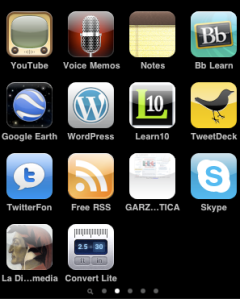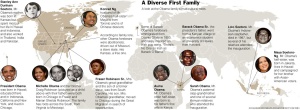I was fortunate enough to have a paper accepted at the 26th annual conference of Calico ’09, my first Calico conference ever. It was an experience that surpassed any and all expectations (how often can we say that?!). Different aspects of the conference that made it so memorable include the venue, the presentations, the participants and the discussions that happened online and off.
Arizona State University is a large, modern campus abounding with art, architecture and green space. The fact that the talks were mainly in the lower level of Coor Hall (a glass ice cube with etched text fragments and letterforms) could easily be forgiven, given they were fully equipped to meet all our tech needs.
The presentations I attended were, for the most part, very interesting and engaging. There were 6 concurrent sessions, which made selecting a session quite difficult. Thankfully, there will be podcasts and presentations available on the site (organized by @msiskin) so anything I missed I can listen to at a later date. Getting a glimpse of the gamut of investigations conducted in technology (more specifically, Web 2.0 applications) and foreign/second language learning, was very inspiring. The range of research is incredible…but as @glordward mentioned in her session, we are such preliminary stages of research, focusing much of our research agenda on students’ evaluation of the implementation of various tech tools. Hopefully, in the very near future we will begin to see investigations that demonstrate concrete evidence in terms of benefits to language learning in terms of increased proficiency.
My presentation, 4:30 on the Friday afternoon, went well. I had a smaller turnout (read below to find relativity in this statement) but was well-tweeted on the back-channel thanks to @judifranz, @glordward and @eRomanMe. It was the Pageflakes project, about which I have previously posted, on which I collaborated with @kahnp and @hellermd98. Another little bonus was the idea of Twitter Crowd Status as a widget, thanks to the ingeniuty @sethdickens, which the audience seemed to like.
The participants in the various sessions I attended were equally as engaging as the presenters themselves. I met a number of intelligent, interesting and committed scholars and researchers who provided feedback and were involved in each session. Being able to connect with these people, network with them was rewarding. Even more rewarding would be future collaborations and/or discussions.
From this, I must highlight two different things that occurred during the conference that impacted me the most, both related to Twitter.
The Twitter back-channel
This is the first conference that I attended that had as much of an online discussion via Twitter as it did in the actual presentations. The dynamic presenters were so engaging that they created discussions both in the session and on twitter. Many people in our respective communities joined in on points raised during the presentations as we tweeted them. Read, for example, @eslchill’s post about his presentation being retweeted (i.e., shared with a different twitter following by a member of @eslchill’s community) by someone who wasn’t at the conference. It is a great success when you find approximately 22 pages in a search for the #calico09 hashtag. (Btw, the other hashtag used was #calico2009)
This was a great experience for me, the avid twitter aficionada, to participate actively with so many other great twitter conference goers. Additionally, I had received a DM re a position opening, and that given my interests, as indicated by my tweets at the conference, I might be interested in pursuing. LOL! If only this had happened pre-tenure, maybe I would have considered it 😉
An impromptu presentation on Twitter
My first day at the conference (the first day of sessions) brought about another personal success. There was a presentation to be given, entitled “24/7 Twitter” at 11:00 a.m. The classroom was full—standing room only (about 50+ people; great news for Twitterati). However, the presenter was a no-show. After a few moments, the chair of the session asked if there was anyone who wanted to say something about Twitter. The phenomenal Claire Siskin (@cbsiskin) spoke briefly to what an effective tool Twitter is and then I, in a moment of self-indulgence, commented that the 4th chapter of the monograph, which was given at registration, was based on my initial investigation on Twitter in the intermediate Italian class.
One thing led to another, then I heard myself saying: “Well, if you would like, I could give the presentation. I have my flash drive with me.” Yes, what a über geeky thing to say! The audience was very indulgent and I gave my impromptu talk about my work with Twitter and language learning. I must admit, this was one of my most rewarding, professional experiences.
Calico ’09 was an amazing conference and I look forward to the next year’s conference in Boston. From the conference program, I created this wordle to give you an idea as to the top 200 terms. Enjoy 🙂





